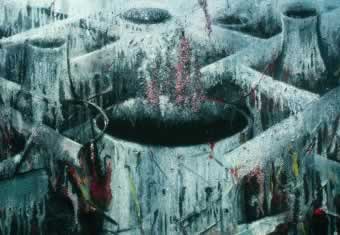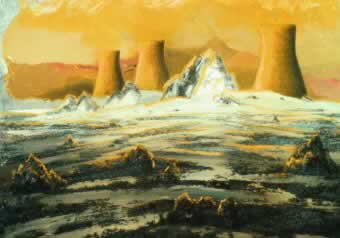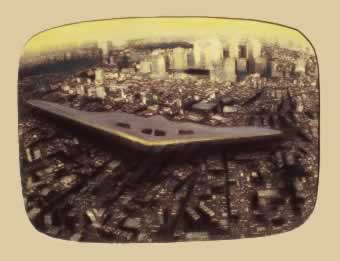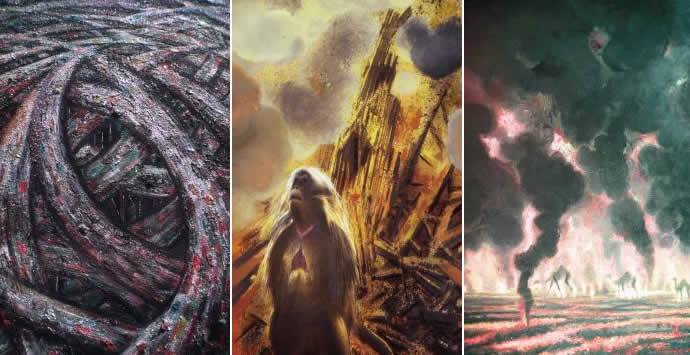
Now I try in some way to protest the destruction of our natural world. In my paintings I point out the various environmental problems which affect me most strongly. The solutions I offer are simple: don’t buy vanity products, use less, recycle more, reproduce fewer humans and keep writing your politicians and vote!
Landscape painting in the nineteenth century was gorgeous and romantic. The huts, the poor and the garbage were left out of the picture. Our century has often leaned in the opposite direction and pounced on the doctrine of “WHAT’S NEW?” Paint and canvas were called passé. An avant-garde artist shot a dog on TV, rivers were diverted at their source, holes blasted in the desert, mountain peaks painted blue and whole coasts wrapped in plastic. All were “art forms” without regard for the earth and its creatures. Ironically, some of these events were called earth art or environmental art.
My work was initially focusing on the beauty of the land, but the more I saw of the toxic landscapes, the more I felt the need to respond. In fact, I even began to use materials that looked like the toxic landscape, iridescent pigments, glitter, silver industrial paint, collage detritus and creatures washed up on the beach. The images of industrial waste sites with rainbow puddles and colorful gaseous plumes, nuclear power plants, dump sites and urban sprawl both repelled and fascinated me at the same time. I even visited three mile island after the meltdown to see what a disaster site like that really looked like. I called this series The Industrial Park since it reminded me of the Orwellian notion of history being revised, or in his words, “Doublespeak,” The word park once conjured up images of idyllic green glades with streams and wildlife. Now vast fields of storage tanks filled with gas and oil are being called Tank Farms, and the land is sealed away in asphalt. And with a true Orwellian spin, clear cutting is called “making open space,” and lies are called “ misinformation.”
At one point I realized that the materials I was using were also toxic. I knew that all paint had some toxic properties, but not to the degree that affected me. I inhaled the pigments, and developed a lung condition which my doctor thought might be cancer. Subsequently, I had lung surgery and spent long months recuperating. Fortunately, it was a benign condition, but a warning never the less. (I now try to work out of doors or in a well ventilated area and use a mask.) Yes, the landscape is toxic and so are our materials.
After 30 years of living in New York City, my husband and I moved to a small Island on the East Coast, approachable only by ferryboat. This is where I live and continue to work. Chickadees take seed from my hand, and deer and fox visit my yard daily. In spite of its beauty, the problems that plague the world are to be found here as well. Plum Island, an animal disease experimental center is 11 miles away, our water supply is threatened by pollution and drought, thoughtless development is creating urban sprawl, and the indomitable tick, carrier of many mysterious diseases, thrives.
Having traveled to countries such as Zimbabwe, Botswana, Ecuador, Mexico and most recently, Cuba, I realize that many things we regard as environmental problems are caused by affluence and aggressive consumption. One of my paintings in the Puffin Foundations’ traveling “Toxic Landscapes” exhibition, in Havana, depicts monster utility towers with power and communication lines marching across the land. These towers would probably be welcomed as would nuclear energy (in spite of the risks) in countries where the essentials such as clean water, medical care, and even food are lacking. Our endless highways, packed with cars spewing fumes, is another of the pollution topics I have painted many times. How many people could resist trading in their bicycle or donkey for a car, if they could afford it?
Nevertheless, there are common problems that we all share and can address. I am hopeful about the future because so many people are now aware of the fragility of our world and want to do more to keep it alive.
I plan to continue painting my environmental pieces and even a few beautiful spots—after all, painting in itself is an affirmation of life.
 Industrial Park Reactors – iridescent pigments, collage, silver oil paint, 41x29"
Industrial Park Reactors – iridescent pigments, collage, silver oil paint, 41x29"

Golden Reactors – oil and pastel, 30x22".

Stealth Bomber – mixed media, 18"x12"
Janet Culbertson's first New York City exhibit was "Elegy to Nature." Since then she has been "depicting the many diverse aspects of how we love yet exploit nature." She developed a personal myth called Mythmaker, about a woman hero which dealt with her commitment to nature. A series of 20 drawings based on Mythmaker is now in the collection of the National Museum of Women in the Arts in Washington D.C. and will be on view from October 15, 2004 through February 6, 2005). Culbertson's concern about vanishing nature led her to paint a Billboard series and, more recently, an Industrial Park series which contrast the beauty of nature with our destruction of it.
All images © Janet Culbertson
Artist website: janetculbertson.net
Janet Culbertson
Above:
Paving America #5 – toy cars and iridescent pigments, 22x30"
9/11 Baboon – mixed media, paint and pigments, 15x24"
Burning Camels – oil paint, 22x30"
